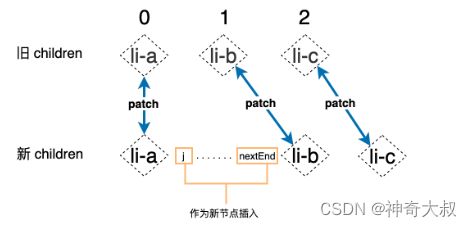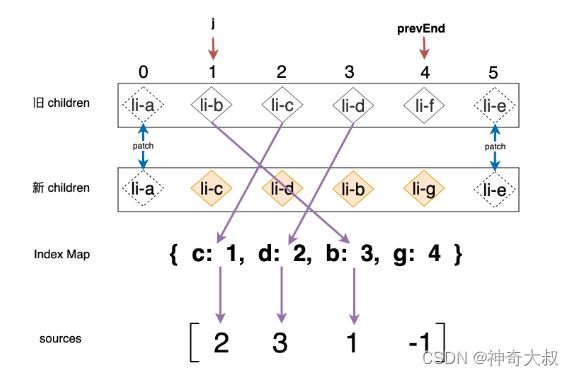文章目录
- 查找相同前后缀
-
- 通过前后缀位置信息新增节点
- 通过前后缀位置信息删除节点
- 中间部份 diff
-
- 判断节点是否需要移动
- 删除节点
-
- 移动和新增节点
-
- 求解最长递增子序列位置信息
查找相同前后缀

- 如上图所示,新旧 children 拥有相同的前缀节点和后缀节点
- 对于前缀节点,我们可以建立一个索引,指向新旧 children 中的第一个节点,并逐步向后遍历,直到遇到两个拥有不同 key 值的节点为止
let j = 0
let prevVNode = prevChildren[j]
let nextVNode = nextChildren[j]
while (prevVNode.key === nextVNode.key) {
patch(prevVNode, nextVNode, container)
j++
prevVNode = prevChildren[j]
nextVNode = nextChildren[j]
}
- 对于相同的后缀节点,由于新旧 children 中节点的数量可能不同,所以我们需要两个索引分别指向新旧 children 的最后一个节点,并逐步向前遍历,直到遇到两个拥有不同 key 值的节点为止
let prevEnd = prevChildren.length - 1
let nextEnd = nextChildren.length - 1
prevVNode = prevChildren[prevEnd]
nextVNode = nextChildren[nextEnd]
while (prevVNode.key === nextVNode.key) {
patch(prevVNode, nextVNode, container)
prevEnd--
nextEnd--
prevVNode = prevChildren[prevEnd]
nextVNode = nextChildren[nextEnd]
}
通过前后缀位置信息新增节点
j: 1
prevEnd: 0
nextEnd: 1
- 发现 j > prevEnd 并且 j <= nextEnd,这说明当新旧 children 中相同的前缀和后缀被更新之后,旧 children 中的节点已经被更新完毕了,而新 children 中仍然有剩余节点,通过上图可以发现,新 children 中的 li-d 节点,就是这个剩余的节点。实际上新 children 中位于 j 到 nextEnd 之间的所有节点都应该是新插入的节点:

if (j > prevEnd && j <= nextEnd) {
const nextPos = nextEnd + 1
const refNode =
nextPos < nextChildren.length ? nextChildren[nextPos].el : null
while (j <= nextEnd) {
mount(nextChildren[j++], container, false, refNode)
}
}
通过前后缀位置信息删除节点

- 在这个案例中,当“去掉”相同的前缀和后缀之后,三个索引的值为:
j: 1
prevEnd: 1
nextEnd: 0
- 这时条件 j > nextEnd 并且 j <= prevEnd 成立,通过上图可以很容的发现,旧 children 中的 li-b 节点应该被移除,实际上更加通用的规则应该是:在旧 children 中有位于索引 j 到 prevEnd 之间的节点,都应该被移除
if (j > prevEnd && j <= nextEnd) {
const nextPos = nextEnd + 1
const refNode =
nextPos < nextChildren.length ? nextChildren[nextPos].el : null
while (j <= nextEnd) {
mount(nextChildren[j++], container, false, refNode)
}
} else if (j > nextEnd) {
while (j <= prevEnd) {
container.removeChild(prevChildren[j++].el)
}
}
- 假设在第一个 while 循环结束之后,索引 j 的值已经大于 prevEnd 或 nextEnd,那么还有必须执行第二个 while 循环吗?答案是没有必要,这是因为一旦索引 j 大于 prevEnd 则说明旧 children 中的所有节点都已经参与了 patch,类似的,如果索引 j 大于 nextEnd 则说明新 children 中的所有节点都已经参与了 patch,这时当然没有必要再执行后续的操作了。
while (prevVNode.key === nextVNode.key) {
patch(prevVNode, nextVNode, container)
j++
if (j > prevEnd || j > nextEnd) {
break;
}
prevVNode = prevChildren[j]
nextVNode = nextChildren[j]
}
prevVNode = prevChildren[prevEnd]
nextVNode = nextChildren[nextEnd]
while (prevVNode.key === nextVNode.key) {
patch(prevVNode, nextVNode, container)
prevEnd--
nextEnd--
if (j > prevEnd || j > nextEnd) {
break outer
}
prevVNode = prevChildren[prevEnd]
nextVNode = nextChildren[nextEnd]
}
if(!(j > prevEnd && j>prevEnd)){
if (j > prevEnd && j <= nextEnd) {
} else if (j > nextEnd) {
}
}
中间部份 diff

- 首先,我们需要构造一个数组 source,该数组的长度等于新 children 在经过预处理之后剩余未处理节点的数量,初始化该数组中每个元素的初始值为 -1
- 实际上 source 数组将用来存储新 children 中的节点在旧 children 中的位置,后面将会使用它计算出一个最长递增子序列,并用于 DOM 移动

- 再建立一个 Index Map 中的键是节点的 key,值是节点在新 children 中的位置索引,用空间来换取时间上的优化

if (j > prevEnd && j <= nextEnd) {
} else if (j > nextEnd) {
} else {
const nextLeft = nextEnd - j + 1
const source = []
for (let i = 0; i < nextLeft; i++) {
source.push(-1)
}
const prevStart = j
const nextStart = j
let moved = false
let pos = 0
const keyIndex = {}
for(let i = nextStart; i <= nextEnd; i++) {
keyIndex[nextChildren[i].key] = i
}
for(let i = prevStart; i <= prevEnd; i++) {
prevVNode = prevChildren[i]
const k = keyIndex[prevVNode.key]
if (typeof k !== 'undefined') {
nextVNode = nextChildren[k]
patch(prevVNode, nextVNode, container)
source[k - nextStart] = i
if (k < pos) {
moved = true
} else {
pos = k
}
} else {
}
}
}
判断节点是否需要移动
- 在上一步代码中,遍历旧 children 的剩余未处理节点,通过索引表快速找到新 children 中具有相同 key 的节点的位置
- 如果新旧节点位置没有变化,那么位置信息应该是相同的,否则,新节点索引表信息为[1,2,3,4],如果映射成旧节点为[1,2,4,3],说明旧节点的最后一个位置和前面的位置互换了,说明节点移动了
const prevStart = j
const nextStart = j
let moved = false
let pos = 0
const keyIndex = {}
for(let i = nextStart; i <= nextEnd; i++) {
keyIndex[nextChildren[i].key] = i
}
for(let i = prevStart; i <= prevEnd; i++) {
prevVNode = prevChildren[i]
const k = keyIndex[prevVNode.key]
if (typeof k !== 'undefined') {
nextVNode = nextChildren[k]
patch(prevVNode, nextVNode, container)
source[k - nextStart] = i
if (k < pos) {
moved = true
} else {
pos = k
}
} else {
}
}
删除节点
删除未查找到的节点
- 拿旧 children 中的节点尝试去新 children 中寻找具有相同 key 值的节点,但并非总是能够找得到,当 k === ‘undefined’ 时,说明该节点在新 children 中已经不存在了,这时我们应该将其移除
for(let i = prevStart; i <= prevEnd; i++) {
prevVNode = prevChildren[i]
const k = keyIndex[prevVNode.key]
if (typeof k !== 'undefined') {
} else {
container.removeChild(prevVNode.el)
}
}
删除多余节点
- 旧 children 中已经更新过的节点数量应该小于新 children 中需要更新的节点数量,一旦更新过的节点数量超过了新 children 中需要更新的节点数量,则说明该节点是多余的节点,我们也应该将其移除
const nextLeft = nextEnd - j + 1
let patched = 0
for (let i = prevStart; i <= prevEnd; i++) {
prevVNode = prevChildren[i]
if (patched < nextLeft) {
const k = keyIndex[prevVNode.key]
if (typeof k !== 'undefined') {
nextVNode = nextChildren[k]
patch(prevVNode, nextVNode, container)
patched++
source[k - nextStart] = i
if (k < pos) {
moved = true
} else {
pos = k
}
} else {
container.removeChild(prevVNode.el)
}
} else {
container.removeChild(prevVNode.el)
}
}
移动和新增节点

最长递增子序列
- source 数组的值为 [2, 3, 1, -1],很显然最长递增子序列应该是 [ 2, 3 ],换算成位置信息是 [ 0, 1 ]
- 而最长递增子序列是 [ 0, 1 ] 这告诉我们:新 children 的剩余未处理节点中,位于位置 0 和位置 1 的节点的先后关系与他们在旧 children 中的先后关系相同。或者我们可以理解为位于位置 0 和位置 1 的节点是不需要被移动的节点
- 只有 li-b 节点和 li-g 节点是可能被移动的节点,但是我们发现与 li-g 节点位置对应的 source 数组元素的值为 -1,这说明 li-g 节点应该作为全新的节点被挂载,所以只有 li-b 节点需要被移动
- 使用 for 循环从后向前遍历新 children 中剩余未处理的子节点
- 这里的技巧在于 i 的值的范围是 0 到 nextLeft - 1,这实际上就等价于我们对剩余节点进行了重新编号。接着判断当前节点的位置索引值 i 是否与子序列中位于 j 位置的值相等,如果不相等,则说明该节点需要被移动;如果相等则说明该节点不需要被移动,并且会让 j 指向下一个位置
- 节点需要被怎么移动呢?找到 li-b 节点的后一个节点(li-g),将其插入到 li-g 节点的前面即可
if (moved || source.indexOf(-1)!==-1) {
const seq = lis(sources)
let j = seq.length - 1
for (let i = nextLeft - 1; i >= 0; i--) {
if (source[i] === -1) {
const pos = i + nextStart
const nextVNode = nextChildren[pos]
const nextPos = pos + 1
mount(
nextVNode,
container,
false,
nextPos < nextChildren.length
? nextChildren[nextPos].el
: null
)
} else if (i !== seq[j]) {
const pos = i + nextStart
const nextVNode = nextChildren[pos]
const nextPos = pos + 1
container.insertBefore(
nextVNode.el,
nextPos < nextChildren.length
? nextChildren[nextPos].el
: null
)
} else {
j--
}
}
}
}
求解最长递增子序列位置信息
[ 0, 8, 4, 12, 2, 10]
[ 3, 2, 2, 1, 2, 1]
- 如上可知最长子序列长度为 3,从右往左遍历查找子序列长度为2位置,接着查找为1的位置,这样就能找到所有的位置信息
[ 0, 8, 12 ]
[ 0, 8, 10 ]
[ 0, 4, 12 ]
[ 0, 4, 10 ]
[ 0, 2, 10 ]






